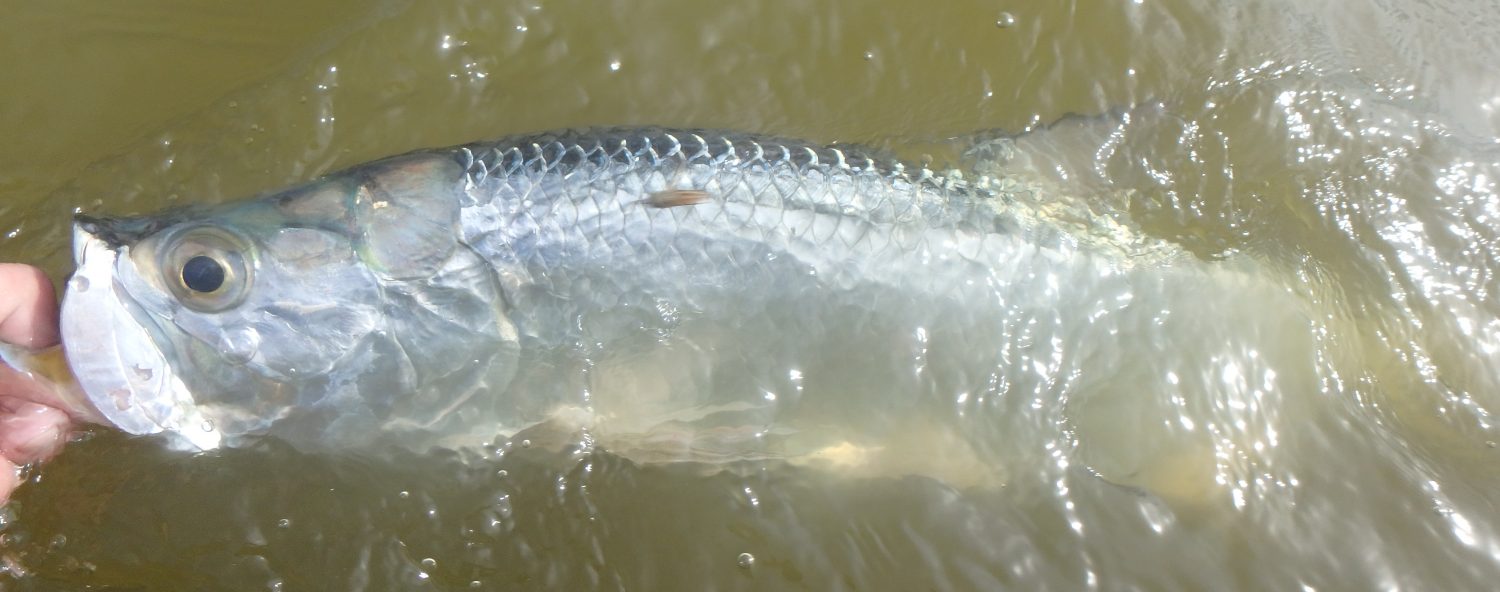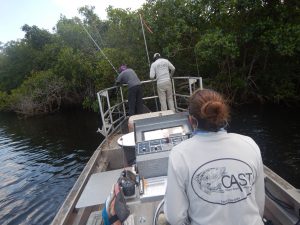 Long-term monitoring of fish populations in the mangrove habitats of the Shark River
Long-term monitoring of fish populations in the mangrove habitats of the Shark River
In collaboration with Florida Coastal Everglades Long-Term Ecological Research Program (https://fcelter.fiu.edu/) and the U.S Army Corp of Engineers RECOVER team (https://www.saj.usace.army.mil/Missions/Environmental/Ecosystem-Restoration/RECOVER/), the Rehage Lab is in its 16th year conducting 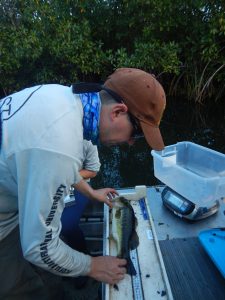 research in the Shark River to better understand the community dynamics of fish populations, their distribution and movement patterns throughout mangrove habitats Everglades National Park. A key aspect of our work is tracking the timing and magnitude of pulses of prey species (i.e. sunfishes) that move seasonally from drying marshes into larger riverine channels during falling water levels, and how these pulses align with the movement, abundance, and distribution of recreationally and ecologically important predators such as Common Snook (Centropomus undecimalis) and Florida Largemouth Bass (Micropterus salmoides floridae). Our current research questions investigate how seasonal/annual variations in flow and water level, along with the influence of extreme climate events such as hurricanes, affect movements related to foraging and reproduction. We use boat-based electrofishing to conduct monthly sampling of the fish community in the upper Shark River, and utilize passive acoustic telemetry to track fish along an ecological gradient spanning the headwaters to the Gulf of Mexico. By providing timely information on the drivers of fish movement, and the environmental conditions that create productive fish habitats, our research can inform water management and Everglades restoration decisions in order to help maintain productive fisheries well into the future.
research in the Shark River to better understand the community dynamics of fish populations, their distribution and movement patterns throughout mangrove habitats Everglades National Park. A key aspect of our work is tracking the timing and magnitude of pulses of prey species (i.e. sunfishes) that move seasonally from drying marshes into larger riverine channels during falling water levels, and how these pulses align with the movement, abundance, and distribution of recreationally and ecologically important predators such as Common Snook (Centropomus undecimalis) and Florida Largemouth Bass (Micropterus salmoides floridae). Our current research questions investigate how seasonal/annual variations in flow and water level, along with the influence of extreme climate events such as hurricanes, affect movements related to foraging and reproduction. We use boat-based electrofishing to conduct monthly sampling of the fish community in the upper Shark River, and utilize passive acoustic telemetry to track fish along an ecological gradient spanning the headwaters to the Gulf of Mexico. By providing timely information on the drivers of fish movement, and the environmental conditions that create productive fish habitats, our research can inform water management and Everglades restoration decisions in order to help maintain productive fisheries well into the future.
 The influence of salinity and productivity gradients on energy flow and food web structure across the Florida Coastal Everglades
The influence of salinity and productivity gradients on energy flow and food web structure across the Florida Coastal Everglades
Understanding the trophic structure of coastal systems and how varying environmental conditions alter trophic pathways are critical steps towards gaining a comprehensive understanding of how ecosystem functioning will change over time. The Florida Coastal Everglades has been profoundly impacted by anthropogenic hydrological alterations and its hydrology is predicted to be further altered by sea level rise. This system is also currently the subject of one of the largest hydrological restoration efforts ever attempted. This confluence of circumstances underlies the importance of establishing a knowledge base from which to evaluate the effects environmental variability have on the pathways of trophic flux across this system. This information is vital for developing a predictive understanding of how the functional attributes of this system may change amid future climate variability, and to establish baselines in which to evaluate the effects of the Comprehensive Everglades Restoration Plan on trophic functioning across the system. 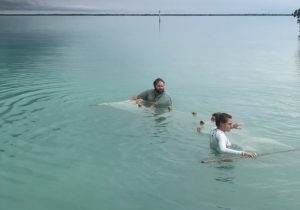 The goal of this project is to characterize the trophic structure along the FCE LTER transect spanning the marsh-riverine-estuarine-marine habitats that comprise the Florida Coastal Everglades, and to identify changes is resource contributions to consumers over seasonal and spatial gradients in salinity and primary productivity in response to the changing influence of marine and freshwater as a function of restoration and climate change. Building on previous food web research within verglades habitats using stable isotope analysis, this project, a critical part of research in the Florida Coastal Everglades FCE Long term Ecological research program funded by the National Science Foundation (FCE LTER https://fcelter.fiu.edu/) aims to construct a comprehensive model of food web dynamics across the Coastal Everglades landscape that will provide a framework for understanding system-wide patterns of trophic flux across the region. The project is a collaboration among the Trexler, Fourqurean, and Heithaus labs at FIU and the Nelson lab at the Univ of Lousiana, Lafayette.
The goal of this project is to characterize the trophic structure along the FCE LTER transect spanning the marsh-riverine-estuarine-marine habitats that comprise the Florida Coastal Everglades, and to identify changes is resource contributions to consumers over seasonal and spatial gradients in salinity and primary productivity in response to the changing influence of marine and freshwater as a function of restoration and climate change. Building on previous food web research within verglades habitats using stable isotope analysis, this project, a critical part of research in the Florida Coastal Everglades FCE Long term Ecological research program funded by the National Science Foundation (FCE LTER https://fcelter.fiu.edu/) aims to construct a comprehensive model of food web dynamics across the Coastal Everglades landscape that will provide a framework for understanding system-wide patterns of trophic flux across the region. The project is a collaboration among the Trexler, Fourqurean, and Heithaus labs at FIU and the Nelson lab at the Univ of Lousiana, Lafayette.
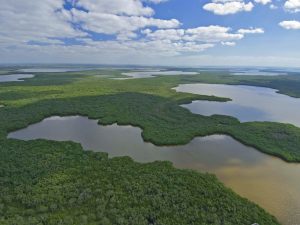 Habitat use and foraging ecology of key recreational fish species along abiotic & productivity gradients in coastal Everglades lakes
Habitat use and foraging ecology of key recreational fish species along abiotic & productivity gradients in coastal Everglades lakes
Reductions of freshwater inflow to the coast have resulted in increased enrichment in coastal subestuarine habitats along the brim of Florida Bay. The causes of this enrichment remain unresolved, but effects include changes and gradients in total Phosphorus and Nitrogen, submerged aquatic vegetation, salinities and oxygen levels, all of which should be relevant to the scales of movement, distributions and foraging ecology of fish, included valuable recreational fisheries. The Coastal Everglades Lakes project, located in North-Central Florida Bay, seeks to understand how recreationally important fisheries use and forage across two embayments with varying nutrient state. 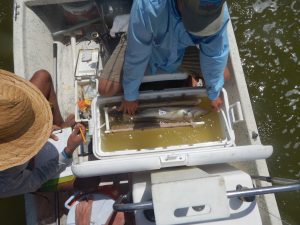 In partnership with the South Florida Water Management District (https://www.sfwmd.gov/our-work/everglades), our research asks: How does enrichment alter prey production and thus the trophic ecology of key resident species such as Common Snook and Atlantic Tarpon and thus how these species move and distribute themselves across abiotic gradients? The currently altered states if the Alligator Creek and McCormick Creek subestuaries provides an ideal comparative research platforms to examine how restoration efforts to return clean, freshwater to the coastal Everglades will impact the recreational fish communities in the region. By tracking the movements of recreational sport fish via acoustic telemetry and pairing movement data with trophic sampling, we hope to see differences in habitat use between the two distinct bodies of water to inform regional water management.
In partnership with the South Florida Water Management District (https://www.sfwmd.gov/our-work/everglades), our research asks: How does enrichment alter prey production and thus the trophic ecology of key resident species such as Common Snook and Atlantic Tarpon and thus how these species move and distribute themselves across abiotic gradients? The currently altered states if the Alligator Creek and McCormick Creek subestuaries provides an ideal comparative research platforms to examine how restoration efforts to return clean, freshwater to the coastal Everglades will impact the recreational fish communities in the region. By tracking the movements of recreational sport fish via acoustic telemetry and pairing movement data with trophic sampling, we hope to see differences in habitat use between the two distinct bodies of water to inform regional water management.
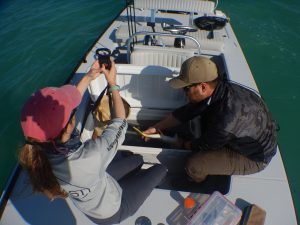 Multiple data sources to assess the status of an undervalued recreational fishery: Crevalle Jack in South Florida
Multiple data sources to assess the status of an undervalued recreational fishery: Crevalle Jack in South Florida
The Crevalle Jack (Caranx hippos) is a large marine fish found throughout the tropical and temperate waters of the North Atlantic. A voracious carnivore, the Crevalle Jack is an important apex predator, targeted by both commercial and recreational anglers. In Everglades National Park, Crevalle Jack is the second most captured species by recreational anglers, with 84,000 landings reported in creel dockside surveys conducted at Flamingo and Everglades City since 1980. Despite Crevalle Jacks being highly-targeted, they are currently an unregulated species and little research has been done to assess life history, track abundance patterns, or determine mortality rates. In recent years, reports from recreational anglers in the Florida Keys indicate a decline in Crevalle Jack catch. 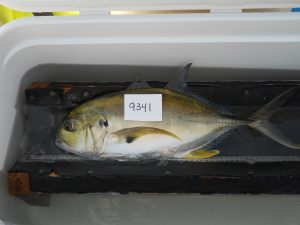 In congruence with these reports, fisheries dependent monitoring by Everglades National Park shows a downward trend in Jack catches. If these data are indicative of a decline in Jack abundance, management efforts will need to be enacted to conserve and restore the population. The purpose of this study is to use a combination of research and angler knowledge to determine spatiotemporal patterns of Crevalle Jack abundance throughout Florida and assess movement and migration patterns. In partnership with the Lower Keys Guide Association (https://lkga.org/), The goal is to determine where and when Crevalle Jack populations began to decline, assess possible factors that may be contributing to the decline, and determine the spatial scale of management that will be necessary to conserve and restore the population. By collaborating with recreational anglers and state management, we hope to develop a sound management plan for the data-poor Crevalle Jack fishery that will successfully restore and conserve this important fish species.
In congruence with these reports, fisheries dependent monitoring by Everglades National Park shows a downward trend in Jack catches. If these data are indicative of a decline in Jack abundance, management efforts will need to be enacted to conserve and restore the population. The purpose of this study is to use a combination of research and angler knowledge to determine spatiotemporal patterns of Crevalle Jack abundance throughout Florida and assess movement and migration patterns. In partnership with the Lower Keys Guide Association (https://lkga.org/), The goal is to determine where and when Crevalle Jack populations began to decline, assess possible factors that may be contributing to the decline, and determine the spatial scale of management that will be necessary to conserve and restore the population. By collaborating with recreational anglers and state management, we hope to develop a sound management plan for the data-poor Crevalle Jack fishery that will successfully restore and conserve this important fish species.
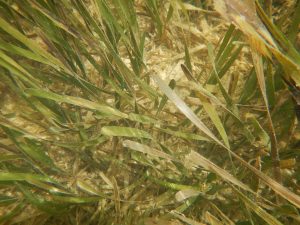 How do recreational fisheries cope with seagrass loss?
How do recreational fisheries cope with seagrass loss?
In 2015, Florida Bay experienced a massive seagrass die-off. Caused by a combination of drought, hypersalinity, high temperatures and low oxygen, the seagrass die-off spanned almost 40 km2 and resembled the 1987-1991 die-off. The loss of seagrass has triggered numerous algal blooms and altered the seascape of north-central Florida Bay, affecting primary production that we expect to cascade to higher trophic levels. However, despite the high socioeconomic value of these higher trophic levels and recreational fisheries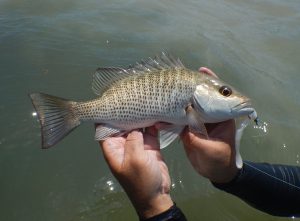 (Common Snook, Red Drum, and Spotted Seatrout), the impact that seagrass die-off had on these species remains poorly understood. Using remote sensing, stable isotope analysis, and acoustic telemetry, and in collaboration with the Nelson lab at University of Lousiana-Lafayette (add hyperlink), FWC FHAP (Florida Bay Fisheries Habitat Assessment Program, https://myfwc.com/research/habitat/seagrasses/projects/active/fhap/) and NOAA’s juvenile sportfish montiroing in Florida Bay (https://www.aoml.noaa.gov/ocd/ocdweb/seatrout.html), we are examining how seagrass loss and fragmentation affects the habitat use, foraging, and movement behavior of recreational sportfish. The 2015 seagrass die-off, while devastating to the local environment, provides a great opportunity to study how fish respond to rapid habitat transformation to inform policy and management.
(Common Snook, Red Drum, and Spotted Seatrout), the impact that seagrass die-off had on these species remains poorly understood. Using remote sensing, stable isotope analysis, and acoustic telemetry, and in collaboration with the Nelson lab at University of Lousiana-Lafayette (add hyperlink), FWC FHAP (Florida Bay Fisheries Habitat Assessment Program, https://myfwc.com/research/habitat/seagrasses/projects/active/fhap/) and NOAA’s juvenile sportfish montiroing in Florida Bay (https://www.aoml.noaa.gov/ocd/ocdweb/seatrout.html), we are examining how seagrass loss and fragmentation affects the habitat use, foraging, and movement behavior of recreational sportfish. The 2015 seagrass die-off, while devastating to the local environment, provides a great opportunity to study how fish respond to rapid habitat transformation to inform policy and management.
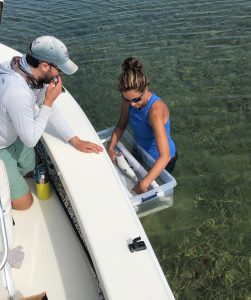 Examining the effects of contaminants in South Florida Bonefish: A Spatial Approach
Examining the effects of contaminants in South Florida Bonefish: A Spatial Approach
In South Florida, the recreational fishing industry accounts for a significant economic impact; the bonefish fishery accounts for $154 million of the $465 million in total economic impact for the Florida Keys fishery. A marked decline in bonefish populations has been observed over the last decades throughout South Florida, which is concerning given the high socioeconomic of the fisheries to South Florida and the Florida Keys. The drivers of the decline are likely multifaceted and remain poorly understood. 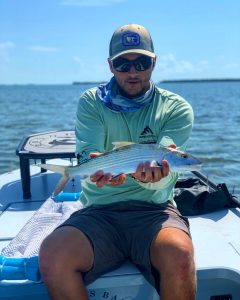 Thus in our study, we aim to assess if contaminants play a role in the decline. In collaboration with Bonefish and Tarpon Trust (https://www.bonefishtarpontrust.org/), the Brodin and Fink Labs at SLU University and Umeå University in Sweden (https://www.slu.se/en/research/academic-events/professors/professors-2019/tomas-brodin/ and https://www.umu.se/en/staff/jerker-fick/) and the Goldberg lab at University of Wisconsin (https://www.vetmed.wisc.edu/people/tgoldberg/), we are using a spatial approach asking how does exposure to key contaminants (copper and pharmaceuticals) vary across the entire Caribbean basin and regions in South Florida ? We will analyze pharmaceutical exposure at a large spatial scale, comparing South Florida to other Caribbean basins, and on a small spatial scale, analyzing the presence of contaminants as a function of distance from shore and contaminant sources and in bonefish as well as via trophic pathways.
Thus in our study, we aim to assess if contaminants play a role in the decline. In collaboration with Bonefish and Tarpon Trust (https://www.bonefishtarpontrust.org/), the Brodin and Fink Labs at SLU University and Umeå University in Sweden (https://www.slu.se/en/research/academic-events/professors/professors-2019/tomas-brodin/ and https://www.umu.se/en/staff/jerker-fick/) and the Goldberg lab at University of Wisconsin (https://www.vetmed.wisc.edu/people/tgoldberg/), we are using a spatial approach asking how does exposure to key contaminants (copper and pharmaceuticals) vary across the entire Caribbean basin and regions in South Florida ? We will analyze pharmaceutical exposure at a large spatial scale, comparing South Florida to other Caribbean basins, and on a small spatial scale, analyzing the presence of contaminants as a function of distance from shore and contaminant sources and in bonefish as well as via trophic pathways.
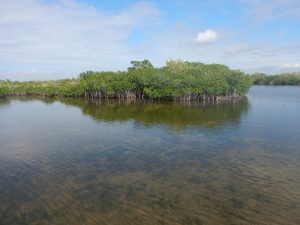 Fish and fishery response to the re-opening of a long-term marine closure
Fish and fishery response to the re-opening of a long-term marine closure
A major portion of the coastal embayments in northeastern Florida Bay have been closed to public access, and thus to recreational fishing since the creation of a crocodile sanctuary in 1980, but the Everglades National Park 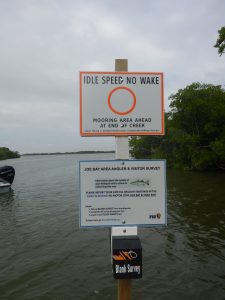 General Management Plan has recently called for the opening of a section of Florida Bay to public, non-motorized access and catch and release fishing. Until now, Joe Bay and Snag Bay were closed to any type of fishing, but these bays have been opened to the entry of human-powered watercraft (eg. kayaks, canoes, SUP’s, polling vessels). We are investigating the baseline fish and recreational fishing conditions of the region, and assessing how this area may change as a result of opening it to fishing, albeit catch and release. A second embayment near Joe Bay that has been closed during the same period will remained closed to any fishing or recreational activity, thus we have a rare research opportunity to use these areas as the treatments in a ‘natural experiment’. Because this area is a national park, we are employing a new state-of-the-art non-invasive technique using baited underwater remote video stations (BRUVS) to conduct the fishing independent sampling. We have also developed a fisheries dependent survey and reporting system for tracking the effect of opening of the region on fishing activity and visitor experiences over time. We are partnering with local anglers and guides, the Everglades National Park, the Snook and Gamefish Foundation and a web/app developer to track the effect of opening of the region via paper and online angler surveys, and a smart phone app reporting system. Together, this information will be used to track fishing pressure, angler catches, fish metrics (fish abundance and diversity, catch composition, fish size), angler preferences, as well overall visitor experience, motivations and preferences.
General Management Plan has recently called for the opening of a section of Florida Bay to public, non-motorized access and catch and release fishing. Until now, Joe Bay and Snag Bay were closed to any type of fishing, but these bays have been opened to the entry of human-powered watercraft (eg. kayaks, canoes, SUP’s, polling vessels). We are investigating the baseline fish and recreational fishing conditions of the region, and assessing how this area may change as a result of opening it to fishing, albeit catch and release. A second embayment near Joe Bay that has been closed during the same period will remained closed to any fishing or recreational activity, thus we have a rare research opportunity to use these areas as the treatments in a ‘natural experiment’. Because this area is a national park, we are employing a new state-of-the-art non-invasive technique using baited underwater remote video stations (BRUVS) to conduct the fishing independent sampling. We have also developed a fisheries dependent survey and reporting system for tracking the effect of opening of the region on fishing activity and visitor experiences over time. We are partnering with local anglers and guides, the Everglades National Park, the Snook and Gamefish Foundation and a web/app developer to track the effect of opening of the region via paper and online angler surveys, and a smart phone app reporting system. Together, this information will be used to track fishing pressure, angler catches, fish metrics (fish abundance and diversity, catch composition, fish size), angler preferences, as well overall visitor experience, motivations and preferences.
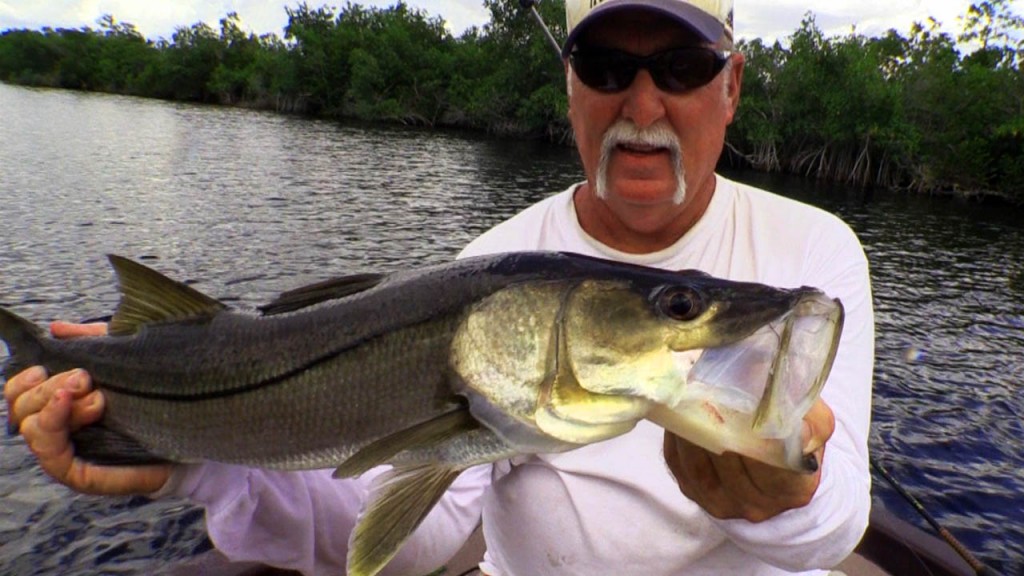 Incorporating anglers & their knowledge into research
Incorporating anglers & their knowledge into research
We have build a stakeholder science program, CAST (Coastal Angler Science Team) whose purpose is to engage anglers into fisheries research.  Our work with anglers is twofold. First, we have tapped into angler knowledge (see project Bay Bones below as well) and their records of catches to examine how their fishing relates to freshwater management and better understand the potential effects of Everglades restoration on recreational angling. For instance, wee have worked with anglers to understand how their 20+ years of common snook and Florida largemouth bass catches are affected by freshwater flows to the coast. Second, CAST has been working with anglers to assist in a mark-recapture study of largemouth bass in order to estimate their survival across years of varying of drying severity. Anglers were equipped with pit tag readers, datasheets and maps and asked to scan their catch. In 2014, we organized a 6-month mark-recapture tournament, and anglers were responsible for 30% of the recaptures that fed our survival model.
Our work with anglers is twofold. First, we have tapped into angler knowledge (see project Bay Bones below as well) and their records of catches to examine how their fishing relates to freshwater management and better understand the potential effects of Everglades restoration on recreational angling. For instance, wee have worked with anglers to understand how their 20+ years of common snook and Florida largemouth bass catches are affected by freshwater flows to the coast. Second, CAST has been working with anglers to assist in a mark-recapture study of largemouth bass in order to estimate their survival across years of varying of drying severity. Anglers were equipped with pit tag readers, datasheets and maps and asked to scan their catch. In 2014, we organized a 6-month mark-recapture tournament, and anglers were responsible for 30% of the recaptures that fed our survival model.
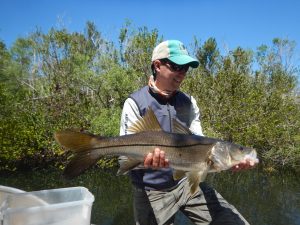 Dynamics of snook in relation to climate
Dynamics of snook in relation to climate
The Snook Tracking Project aims are to understand how the ecology of snook are influenced by climate variation in South Florida. We examine variation that ranges from seasonal to 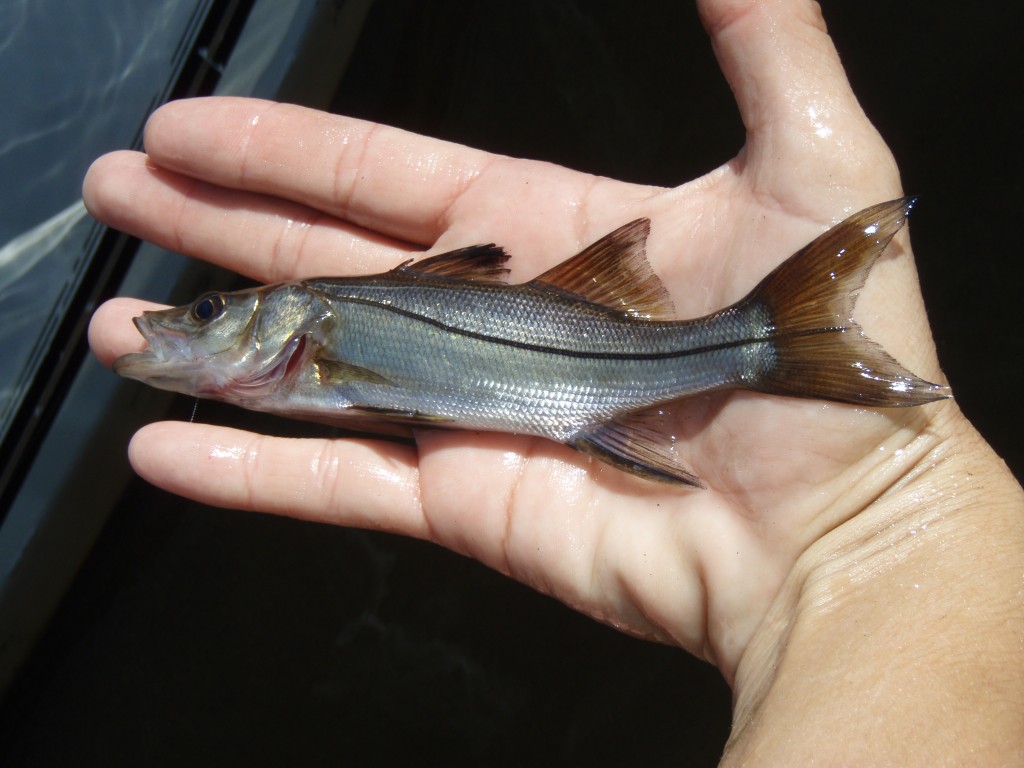 yearly, to decadal and extreme climate events. Currently, we are investigating how climate patterns such as rainfall affect the movement ecology and reproductive biology of snook. The ove aching goal of this project is to both provide key biological information to state resource managers about snook in Everglades National Park, and also enhance our ability to predict the quality of recreational fishing. We plan to test our ability to predict good and bad fishing years-valuable information for fishing guides and the tourism industry in general. We hope our work not only improves the sustainability of the snook fishery within the Everglades, but also increases economic resiliency of professionals that rely on the snook fishery.
yearly, to decadal and extreme climate events. Currently, we are investigating how climate patterns such as rainfall affect the movement ecology and reproductive biology of snook. The ove aching goal of this project is to both provide key biological information to state resource managers about snook in Everglades National Park, and also enhance our ability to predict the quality of recreational fishing. We plan to test our ability to predict good and bad fishing years-valuable information for fishing guides and the tourism industry in general. We hope our work not only improves the sustainability of the snook fishery within the Everglades, but also increases economic resiliency of professionals that rely on the snook fishery.
